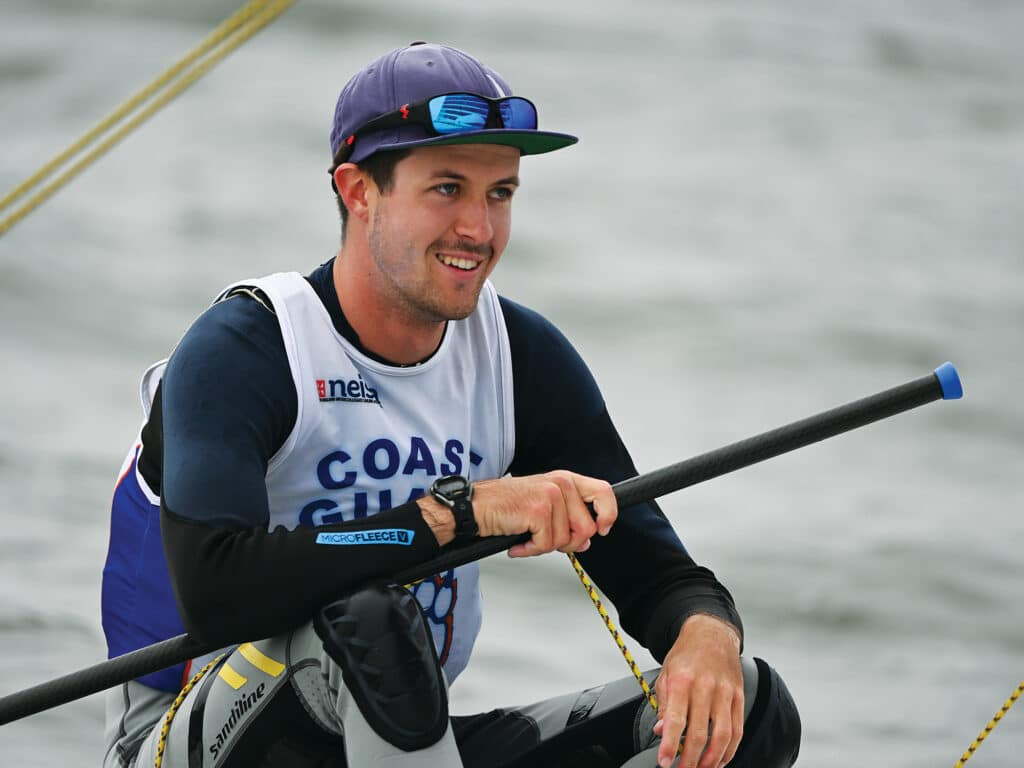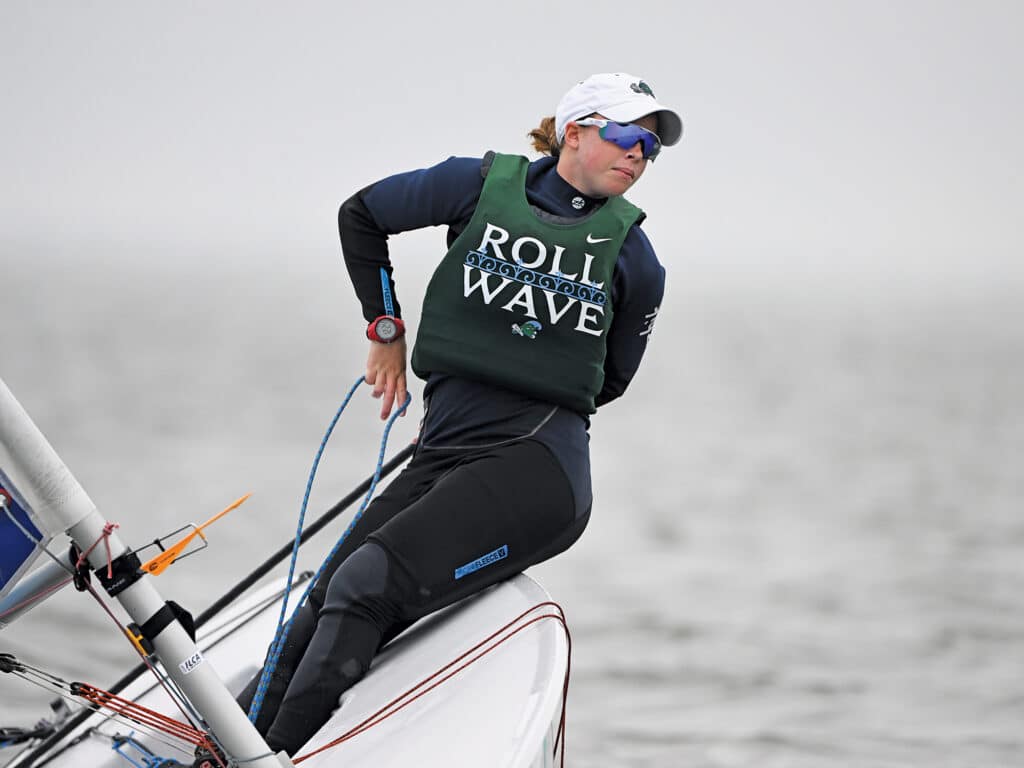
The vast majority of collegiate sailing happens in doublehanded FJ and 420 dinghies, but a dedicated group of ILCA 6 and 7 sailors compete for the annual Intercollegiate Sailing Association’s Singlehanded National Championship. And while singlehanded sailors race only two regattas per year—the regional qualifiers and national championship—the fleet is a staple of collegiate sailing and a breeding ground for US Olympic hopefuls.
Nick Reeser, a junior at the US Coast Guard Academy with an elite ILCA background, is this year’s champion in the fleet. From Fort Lauderdale, Florida, Reeser was a two-time champion of the Orange Bowl International Youth Regatta’s ILCA 6 fleet and a second-place finisher in the ILCA 6 fleet at the 2019 High School Singlehanded National Championship before enrolling at the Coast Guard, where he finished seventh in the ICSA Men’s Singlehanded Championship in 2021. Reeser won this year’s nationals by 11 points after dominating the New England qualifier for the event, finishing 21 points ahead of the second-place finisher.
“Winning in this fleet is all about consistency,” Reeser says. “I didn’t win a single race at the Nationals qualifiers this year. I was aiming to be sixth or seventh at every weather mark and take away a couple of boats on a run; I had to make sure that there was no big risk-taking or critical failures.”
Collegiate singlehanded sailing’s format departs from traditional, long-course ILCA racing for a faster-paced college-style regatta where sailors race upwards of seven 20- to 30-minute races per day. For many orthodox ILCA sailors, adapting to the collegiate format can be a challenge.
“The best way I could describe it is that it’s almost like a different sport,” Reeser says. “In the Laser [ILCA], you work really hard on your fitness and boatspeed, and those two things are often what wins regattas. If you’re 10 percent faster in an hourlong race, you’re able to work your way to the front no matter what. In college sailing, you’re probably killing it if you’re 2 percent faster. There’s not really that much boatspeed gains that you can make because the courses are so short. Everybody’s good, and everybody’s sailing in the same boat.”
The adoption of collegiate sailing rules changes the way the ILCA dinghy can be sailed, according to two-time singlehanded national champion and Yale assistant coach Leo Boucher.
“One of the things that changes in the collegiate fleet is the boathandling,” Boucher says. “You can be a lot more aggressive boathandling-wise in college [ILCA] sailing than you can in world sailing because you’re allowed to come out of tacks and jibes faster.”
As somewhat of a side note to the broader world of collegiate sailing, the Singlehanded National Championship attracts an eclectic mix of sailors who may have not otherwise competed in ICSA events.
“The Laser environment is pretty interesting in the college sailing world because you have a sect of people who are doing an Olympic campaign and happen to be going to college on one hand, and college freshman who put 200 days in the boat the previous year on another,” Reeser says. “You also have people who are more focused on the doublehanded events but sailed ILCAs in high school who may put a couple of days in the boat before the event. It’s a very interesting environment that makes for some interesting and competitive racing.”
One such college freshman is Ava Anderson, a first-year sailor at Tulane who won the women’s division of the Nationals in November. From Houston, Texas, Anderson came into college with both an elite singlehanded and doublehanded dinghy background, having finished 10th in the youth women’s division of the 2023 ILCA 6 Youth World Championships in Dziwnow, Poland, under the tutelage of elite ILCA 6 coach Ryan Minth, and having competed in the 2022 and 2023 doublehanded High School Sailing National Championships.

Anderson finished the 14-race regatta with 74 points, averaging fifth place and winning three races in the 18-boat fleet. Consistently staying in the top-six boats allowed her to stay at the top of an incredibly tight fleet, where every sailor had at least one double-digit finish.
Sailing on home waters at New Orleans’s Southern YC, Anderson’s consistent finishes paid off at the notoriously puffy and shifty venue.
“Sailing toward the puffs, staying in phase, and getting off the line clean to get your speed up are all very important to win on Lake Pontchartrain,” Anderson says. “I felt super-fast during the first two races of the first day when the breeze was up. When it died later in the day, I definitely had a little bit of trouble keeping my speed up.”
Training for singlehanded nationals can be a challenge for many sailors because each collegiate team has only a few ILCA sailors. As the qualifiers for the nationals occur amid other national-level fall collegiate dinghy events, many of the fleet’s top performers must balance training for the singlehanded nationals with staying at the top of the doublehanded fleet.
“Most of the work needs to be done out of season,” Boucher says. “Most of the work you’re going to do to be ready for the singlehanded nationals is going to be done the summer prior to the event. What you can do to prepare in school is to stay as fit as you can; normal team workouts may not be enough for most people, so you might need to add something on top of that.”
Many of the fleet’s top performers must balance training for the singlehanded nationals with staying at the top of the doublehanded fleet.
Collegiate singlehanded sailing provides an on-ramp to top-level doublehanded sailing that many ILCA sailors might have missed in youth sailing. Both Reeser and Boucher have sailed A-level doublehanded events in college despite not focusing on 420 or scholastic sailing as youth racers.
“I was recruited to the Coast Guard to sail Lasers, but there are only two regattas per year, so I threw myself into the FJ and 420 fleets,” Reeser says. “It’s taken me quite a while to figure out how to sail with somebody else and how to set up the boats, but now I spend about 80 to 90 percent of my time on doublehanded sailing.”
Many American Olympic hopefuls have made their mark on the ICSA singlehanded fleet. Boucher won the Men’s Singlehanded Nationals in 2019 and 2021 while sailing for St. Mary’s College of Maryland and is now preparing to compete in the 2024 Olympic trials in February. After coaching at Yale this fall, Boucher has plans to travel to Portugal and Australia to train for the event.
“Because of the way they’ve done the trials format, I think there’s a lot of benefit from doing college sailing because of the small fleet,” Boucher says. “Typically, they use a world or European championship for the qualifier and there are 60 boats on the starting line, whereas now we’re going to have 40. I bet that toward the end of the regatta, you’re going to know who you have to beat, so the college sailing stuff is going to play pretty big into that.”
With Boucher, Reeser and Anderson all planning to attend the trials among countless other ICSA singlehanded champions of years past, it is clear that the collegiate singlehanded format is a boon for many rising stars in the US Olympic ILCA fleet.









